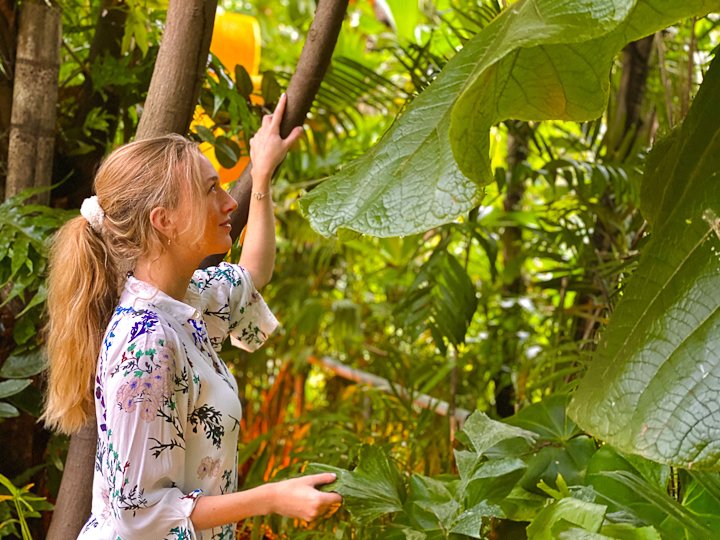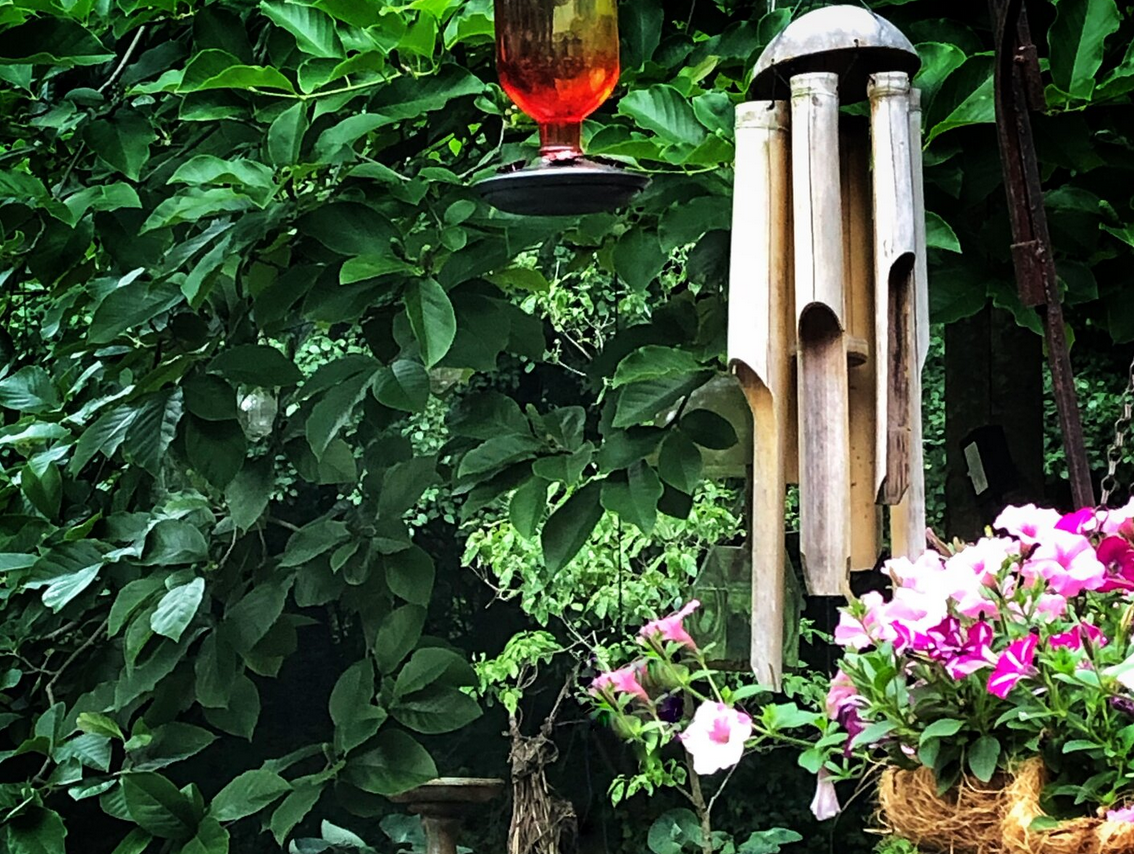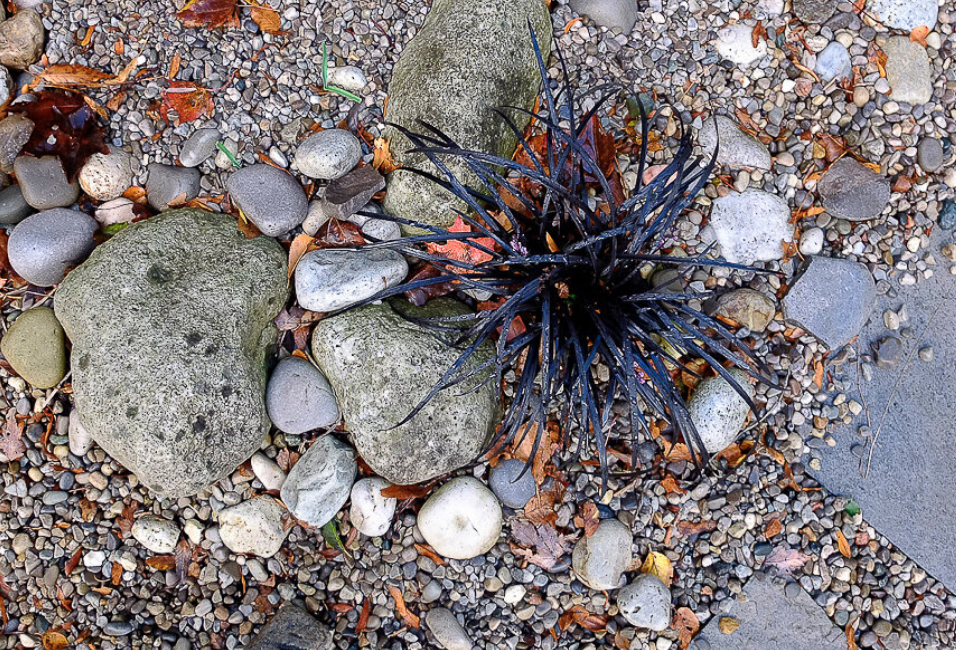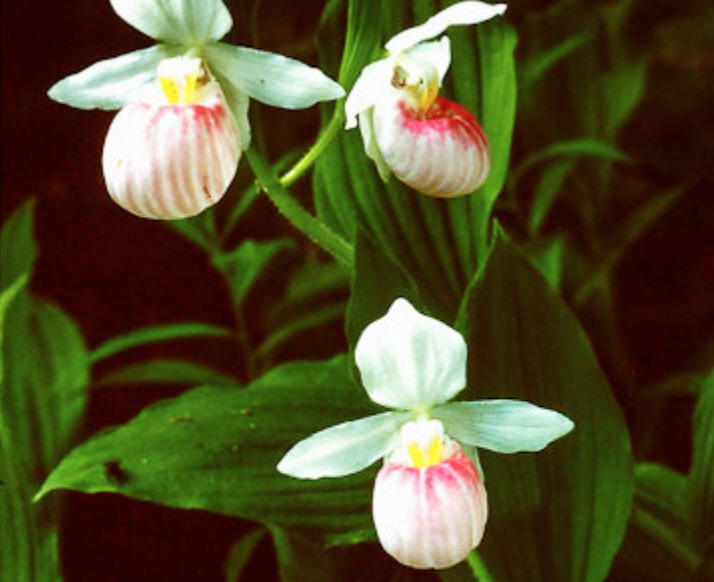Raised planters are a hit in the woodland garden
Living with deer is a wonderful experience. Everyday I see them browsing through the yard is both a joy and a horror. What are they after today? Will the prized hostas survive this time around? So, why not serve them a delicious smorgasbord right at the perfect eating height. We decided to experiment with veggies and herbs this year in raised planters. I know the rabbits can’t get them but I have a feeling the deer are going to thank me big time. Follow along this summer and see if the deer get more produce than I do from our raised-planter experiment.
From veggies to garden nursery, changing strategies
The two raised planters to the left in the photo fit in nicely with the Keter sheds (that’s a second, smaller shed on the right) and the two on-ground planters, also made by Keter, that flank each side of the shed doors.
We bought our home based on a picture the previous owners left on the kitchen table at the open house.
It was a picture of two deer walking through the yard.
That sold it for me.
At the time, my wife, daughter and I were living in the suburbs surrounded by homes, pools and annoying neighbours. I spent my evenings and weekends in the nearby town of Ancaster (where we now live) trying to get photographs of deer. At that time, I was a little obsessed about getting photos of these lovely creatures.
Lots of deer: Careful what you wish for
When we bought the Ancaster home, one of the first projects I did was set up a bird-feeding station. It wasn’t long before the deer came to the bird feeders and it wasn’t long after that I came to the realization that if birds came to my feeders, I bet deer would come to feeders especially made for them.
I was right.
One morning I woke up to 17 deer in the yard waiting for me to go out and fill their feeder.
In fact, by about the third year of feeding the deer, they would be waiting for me when I returned from work around midnight.
For more suggestions and some of my favourite garden things, be sure to check out my Favourite Things post.
Five, six, eight would be in the yard gathered around the feeder. They were so used to me by that time that they would back off only about three feet when I approached them with their special feed of oats and corn.
They became so friendly that I’m sure they would have let me touch them, if I ever tried.
It got to the point where we couldn’t sit outside without being visited by a couple of deer looking for a handout.
The two raised planters are seen here with the woodland garden in the background.
High cost of feeding deer
Eventually, I realized, however, that we could not have anything nice because of the all the deer.
Not only were they eating me out of house and home, but they treated my emerging garden like a smorgasbord – the garden was the salad and the feeder became the main course.
A number of on-line nurseries offer assistance on buying deer-resistant plants. They are worth familiarizing yourself with so you don’t spend a fortune feeding the deer with precious plants.
The Burpee site is another mail-order company offering an extensive list of deer-resistant perennial seeds and plants for purchase through mail order.
I cut down on the food and eventually fewer deer visited looking for handouts.
Don’t get me wrong, they are still welcome in my garden and continue to indulge on our hostas, but the tradeoff of having these magnificent animals around is well worth it to me.
Before I plant anything these days, I check to see if they are deer resistant. I’ll still use plants that I know deer enjoy, but I try to put them in areas that are a little difficult for the deer to reach. It doesn’t work, but I keep trying.
The Keter raised planter pictured here prior to being filled with soil shows the watering system at left and the plastic spacers that both give the unit support and act as dividers for different herbs or veggies.
Lots of visitors to the woodland wildlife garden
Deer, of course, are not the only garden visitors. Rabbits, groundhogs, squirrels (both grey and red) chipmunks and a host of other hungry visitors live here too. So the thought of growing vegetables had never really crossed my mind until recently.
Mary Reynolds’, The Garden Awakening, (see earlier blog) got me thinking about Forest Gardening. A little research on YouTube especially New Jersey YouTuber James Prigioni got me thinking maybe it was time to tackle a little more food cultivation in the garden.
Problem is, besides berries from the many Dogwoods on the property, crabapples, serviceberries and various nuts from trees, I was convinced vegetables and low-growing berry crops would not stand a chance in the garden. There are ways to keep the critters out but I was not interested in fencing my property.
Just fencing off a small area using something like the Pest Free Garden from Gardeners’ Supply Company would certainly get the job done.
But I decided to go with raised planters.
A quick visit to our local big-box store resulted in not one but two handsome black, self watering raised planters made by a company named Keter for a garden area I am developing in front of a new shed. It didn’t hurt that the raised planters were made by the same company that made the shed and, therefore, fit nicely into the grey and black colour scheme. Check out my review of the Keter shed here.
Simple to assemble raised planters
It also was not a coincidence that as soon as I saw the raised planters at Costco, I grabbed them. After purchasing more Keter garden products in the last year and a half than I care to admit, I knew the quality of these Keter Urban Bloomer XL raised planters would be top notch and assembly would be simple and satisfying.
Construction, however, didn’t start well.
I overlooked the instructions for the first planter in the box so, like most men, decided to proceed without them. First thing I did was break a tab off the leg trying to detach it from the packaging. I’m not all that handy, so breaking things before I even get started is not out of the ordinary.
I had three more legs to detach and, for the life of me, I could not figure out how to detach them without breaking them off. Second leg, same thing. Broken tab.
I knew Keter products well enough by now to know that this was not the norm with their products. Everything else I built from them (and like I said there were many) made Ikea look like amateurs.
It was about that time that I discovered the instructions in the box.
Well, guess what? The tabs were meant to be broken off from the packaging material. Wow, I thought to myself, not only do I get to build these things, but I even get to break things on purpose. Life is just too good.
A few minutes later and the first one was built. After already building one (without instructions for the most part), the second one went together even easier and quicker. Within 1/2 an hour or so, both were built and in place ready for soil and seeds.
Keter states that with The Urban Bloomer XL, there’s no need to dedicate lots of space to have a substantial vegetable garden.
And, for us old folks, no need to bend over while planting and harvesting our veggies. That’s a good thing.
The extra-large elevated planter ( capacity of 110 L | 29.06 Gallons) features a shelf for storing gardening supplies and a smart watering system that incorporates special fabric for evaporation and regulated watering.
Its 44.8 inches in length and 18.6 inches in depth provides plenty of space for planting vegetables and herbs. The planters are advertised as UV and weather resistant, requiring virtually no maintenance and are easy to clean. What more can you ask for? A drainage plug at the bottom of the planter provides a convenient way to reduce the amount of water if necessary.
They are also quite light even with soil in them and would make the perfect raised planter for a balcony or small courtyard.
Their dark colour makes them not only a stylish addition to a balcony or patio, but also works to absorb heat to keep plants happy from early Spring through the cooler Fall temperatures.
One thing I can say about Keter is that the vinyls/plastics they use in their products are outstanding.
I’ve always been a natural-materials guy, but when I discovered how realistic Keter products are, I was sold. In fact, the company has won awards for the vinyls they have created. I joke that our grey-weathered shed looks more like weathered cedar than real weathered cedar looks. And it was weathered the day we bought it. I didn’t have to wait for it to take on that beautiful weathered grey colour.
Will they work to keep deer away
Keter doesn’t say anything about deer though.
In fact, after assembling them, I realized that my planters are raised to the perfect height for our four-legged friends to chow down with the greatest of ease.
They will definitely keep the rabbits away but I’m not too sure about the deer.
Oh well, it wouldn’t be the first time I set up a buffet for our resident deer.
And, like I said, watching them enjoy my backyard as much as I do, is a small price to pay.
Just leave me a tomato or two would you guys… I do like my toasted tomatoes.
Throughout the summer, I’ll keep readers updated on my success and failures with my raised planters.
Raised planter update
Okay so after our first summer with the raised planters I can report that I did not see a deer munching my tomatoes. I can also report that the deer missed out because one of our local raccoons got there first. Turns out a local raccoon decided to help itself to the tomatoes and snap pees.
Back to square one. This year we moved the planters around to the side of the house and although I have not given up with the tomatoes and other veggies, I am converting the raised planters to more of a woodland wildlife nursery where I can begin growing woodland flowers and shrubs from cuttings and seeds. I predict that will be a little more productive in the long run.
I hope to pick up some garden cloches from Garden supply to deter the raccoons from what is left of my tomatoes and other veggies.
If you like Keter products, and you are as disorganized as I am, you might want to consider getting their shed tool organizer. Again it’s another high quality product that solves the problem of messy tools cluttering up your tidy shed.
• None of the products in this review were provided to me from Keter. They were all purchased by me at a local Big Box Store.
As an Amazon Associate I earn from qualifying purchases. This page contains affiliate links. If you purchase a product through one of them, I will receive a commission (at no additional cost to you) I only endorse products I have either used, have complete confidence in, or have experience with the manufacturer. Thank you for your support.


















Is the Pentax Q system the ultimate travel camera? Decide for yourself after checking out the results on our European river cruise.